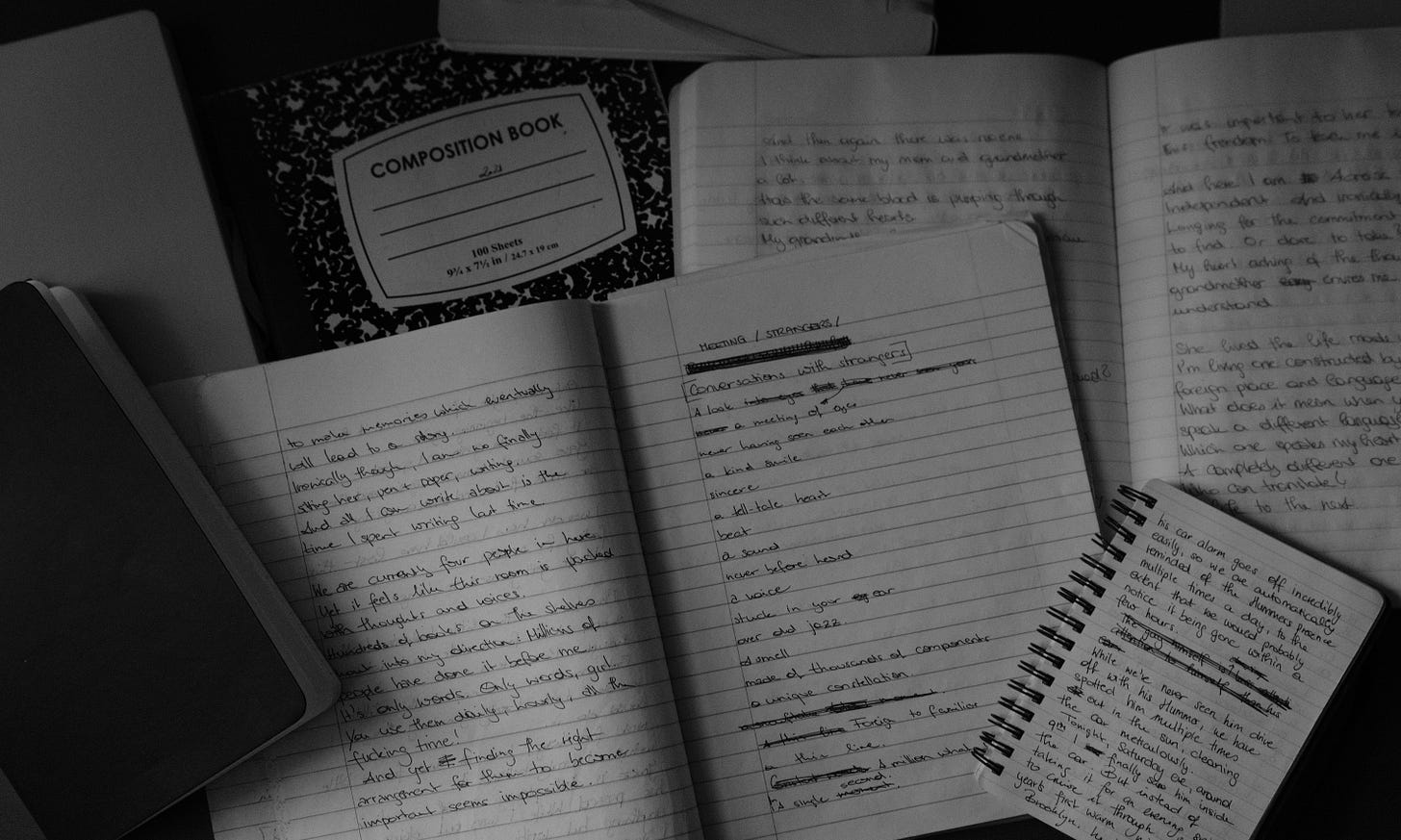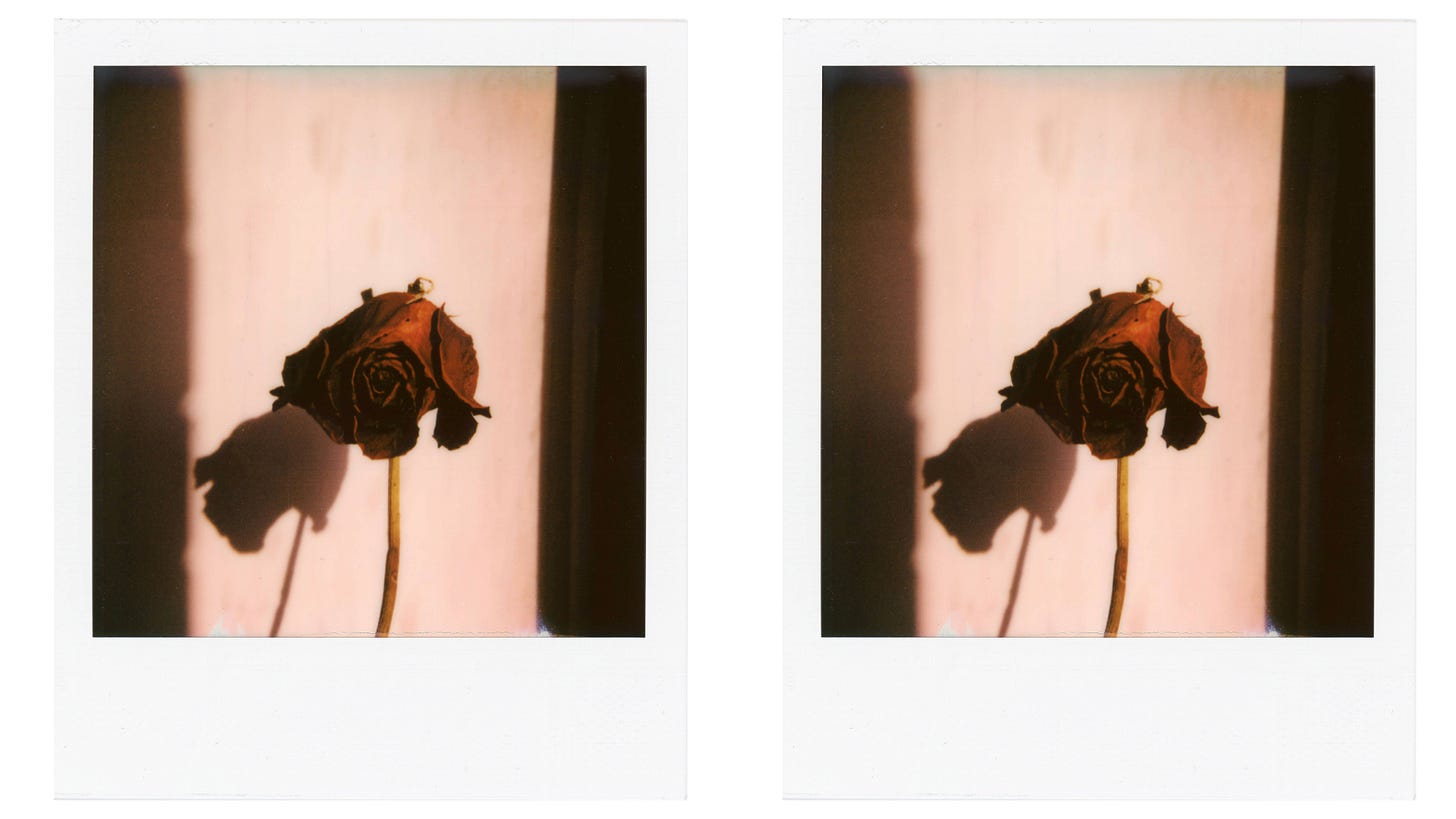“A closet full of clothes and nothing to wear”, in Sex and the City Carrie’s struggle was quickly dismissed as a silly girl-problem. But I honestly think this sentiment reflects a universal struggle in creative pursuits. Clothes and shoes are Carrie’s creative tools, text and images are mine. And I too, have stacks and stacks of filled notebooks; folders and folders of archived negatives and digital files of photographs. And yet, somehow, I have nothing to show to the world.
A conflict, I’ve been struggling for years now: Am I simply my own worst critic? Or could it be true that nothing is good enough yet and I have to continue working towards something I’ll be happy with? Or is the reality perhaps that I am truly fulfilled by the act of creating itself, with no need for external validation?
Create for the sake of creating
In conversations with friends, I have often used the latter as my argument. And to some extent, I actually still believe it. I write and take photos mainly because I enjoy the act of doing it. They’re forms of therapy, meditation, of organizing my thoughts and feelings— not because I am feeling an urge to share all of that with the world, but because I am feeling an urge to write, to photograph. Once my thoughts are on paper, I hardly ever go back to the text. Whatever needed to come out exited my mind and took shape in reality—that was its purpose. With photographs, it feels slightly different, as I do visit the images again, when I scan and edit them. However, the main joy, the moment of inspiration, happened when I pressed the shutter in order to capture whatever caught my eye. Everything that comes after that simply does not seem that important to me.
And then there’s also the importance of being able to create without an audience in mind. I had this conversation recently with a friend of mine who creates most of his work for a YouTube channel, which, he believes, stops him from creating as freely and authentically as he could when he’s just shooting for himself without any intention of publication. I believe that fully, not only because I am a people-pleaser and always worry about what people may think of me (or my work), but even that aside, I believe it is virtually impossible to completely disregard the audience, if the works’ intention is to be shared. [‘sharing’ here does not only apply to social media, but is used as equal to any form of showing work to an audience, eg. publishing]
Taking away the intention of sharing work, however, leaves your work pure. It exists not to be shared, understood and liked, to be bought or admired; it exists for the sake of existing. Because you felt like it needed to exist. That’s beautifully simple — and I wish it was this simple but of course, it’s not.
What’s the point of a painting you can’t look at?
Photographs are by nature visual art, and it seems a little counterintuitive to keep them from people’s eyes. Similarly, I think it is fair to argue that a written text demands to be read in order to be truly valued as a piece of writing.
Is it disrespectful to my own work to not have my texts read or my photographs looked at? People around me usually encourage me to share more of my work and I don’t blame them. Whenever I see a photographer friend post incredible photos, I am the first to urge them to print and frame the photos rather than sending them out into the giant black hole of the metaverse, or worse, let them die on their hard drive.
But then again, perhaps it does not matter how great I think their work is, if they, as the artist, don’t see it up to their standards. At least, that’s how I often feel about my own work and, frankly, that’s also where I stand on debates about famous artists’ work that was shared without their consent.
Take, for example, Franz Kafka and Vivian Maier. Both of these artists, in different ways, did not intend to share their work. Kafka even explicitly stated in his final letters to his friend Max Brod that all his writing shall be destroyed without being read. After consulting with Kafka’s family, Brod ignored his friends’ wishes and did the opposite. What makes this story even sadder is that due to these texts, Kafka became famous for his unresolved father issues and his work became the prime example of interpreting fictional texts based on the author’s personal context.
Kafka’s situation raises a difficult question: Would his writing have been as raw and revealing if he had written with an audience in mind? Possibly not. Most likely, he used the tool of creative writing to work through his personal trauma. The act of writing being the focus, the final text simply being a side product, he wished to discard. Of course, one can argue, that his work ended up progressing modern literature and psychoanalysis, which ultimately helped a lot of people. Of course, we can choose to see the positive effects of a piece of art, but we can’t forget they came at the expense of the artists’ intention and hence their dignity.
Vivian Maier’s story was a little different but in many ways very similar. Her photographs were found and ultimately shared. While we do not have any record of an explicit wish for what to do or not to do with her work, her negatives were kept in a storage space until she was unable to pay for it, shortly before her death. Many of the negatives had been undeveloped when they were found. Even without a direct statement of hers, it seems pretty clear that Maier had no intention whatsoever to share her work with anyone, let alone make it public to the entire world. Naturally, we can never know what her reaction would have been to this international recognition and praise of her photographs, we can only hope she would have been proud or flattered. If she’s anything like me, however, she would have felt exposed and violated.
The multitude of existences
When pondering over this topic and not really coming to any real conclusion myself, I remembered something I heard about in University. I studied English Literature and somewhere amidst the discussion of “the death of the author”, my professor talked about the multiple existences of one single piece of writing. Firstly, there’s the version of the text the author writes—it includes their intention, what they want it to say and mean. And then there is the version the reader reads. This can be very different to the intended text, depending on the readers interpretation, their background, context, etc. Even one and the same reader, can read the same book at different points in their lives and have a completely different experience and understanding of it. As we all learn early on in any semi-decent literature class, there are no wrong interpretations of texts. It’s the author’s job to make the reader interpret what they want them to interpret, or be at peace with the fact that there might be different readings of it. There are, therefore, always different versions of one piece of work, depending on the eyes looking at it. In fact, my professor was arguing, every single read equals a different piece of work. And as a consumer of art, I can certainly attest that this is very often true in my experience. Any emotion a piece of art evokes in me, is mainly based in my personal experience, as the viewer and has little to nothing to do with the artist’s.
So perhaps, the solution to my dilemma is somewhere in here. Maybe it is possible to think of my work as originals and copies. The former remains my own version, and the latter I try to detach myself from and instead imagine it as new piece for the audience to look at and see their own world reflected in.
If I look at it this way, I am able to still create work with the same intention, for the sake of creating, without an audience in mind. I can still see the work as completed, simply by existing, by encapsulating my emotions and helping me work through things. Anything I create, I first and foremost create for me, however that may look like, whatever that may mean. Once this part is completed, I can go back to my body of work and try to find pieces that could work for someone else. Pieces that can be stripped of my intention, of my personal meaning, and can be used as a canvas for someone else’s point of view, perspective and reflection. If I manage to look at it this way, these pieces can exist separate to the original, like a copy someone else can draw on.
I have not yet tested this theory in practice, because ironically, I arrived at this conclusion while writing this text, which proves once again the importance of the act of writing for me. While untested, the mere thought of it feels like it has the potential to lift some weight off me, when trying to convince myself that I should ‘do something’ with my work. It feels like the perfect symbiosis between art and myself: I create art because it ‘does something to me’ and then, in return, and perhaps with a little distance, I can give back and ‘do something with it’.
Thanks for reading!







You and I are writing about very similar things right now! These quotes from Boris Groys helped shape what I think about sharing art. "Under the regime of (art) theory, it is not enough to live: One must also demonstrate that one lives, one must perform being alive."
Also
"To live is to be exposed as living (and not as dead) to the gaze of the Others"
I resonate a lot with your writing.
At the moment, I'm trying to figure out why I want to share my photographic work. Is it because I want to chase "likes" or what is it. I love taking pictures - the act of taking them and maybe edit a bit to make them look nice. But then what? If that's the point, then I could just delete them again? :D
Anyways, I do some writing now. About fatherhood and family life - and that's mostly for myself, as I explore some aspects of myself that I wouldn't think too much about. But I share them here to motivate me to get it done and work with it.
I want people to see it of cause, but mostly to have a dialogue with other people and their experiences.